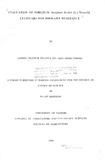| dc.description.abstract | Two field and greenhouse experiments were conducted to evaluate twenty
sorghum cultivars for drought resistance and to identify possible morphological and
physiological traits which could be utilized as selection criteria. The field experiments
were laid out as a randomized complete block design with two replicates. These were
planted at Kibwezi Dryland Field Station during the November 1992-February 1993 and
April-August 1993 seasons. The greenhouse experiments were conducted at Kabete Field
Station from February-September 1993. A split-plot design was employed with watering
treatments forming the main plot treatments while sorghum cultivars comprised the subplot
treatments.
Cultivar differences were observed for most traits scored. Seed yield ranged from
117 g/nr' (in SSKN 0001) to 293 g/nr' (in SSKN 0003) and 65 g/rrr' (in SSKN 0001)
to 208 g/nr' (in KAT 369) during the first and second season respectively. The study
indicated that cultivars EPSONI 029, EPSONI 065, E 525HR, SSKN 0003, KAT 369
and SERENA were the most adapted to the dryland conditions. These cultivars achieved
high absolute yields in both seasons, thus maintaining their yield prowess under the
drought conditions of the second season. Consequently these cultivars showed low yield
reduction and hence fairly stable yields in comparison to susceptible cultivars such as
NAMONIMBIRI, SSKN 0001 and LOCAL SORGHUM BROWN.
Grain yield under the drought conditions of the second season was positively and
significantly correlated with harvest index, panicles per square metre, panicle weight per
plant, seeds per panicle, seed weight, root length density, leaf relative water content andabaxial
stomatal conductance.
In contrast, the drought susceptibility index, seed and biomass yield reduction
were negatively and significantly related to seed yield. The strong association of seed
yield with these traits suggest that these traits may be advantageous for yield and yield
stability under the dryland conditions.
Stepwise regression analysis identified harvest index, drought susceptibility index,
root length density at 45 em and panicle weight per plant as the most important yield
predictors under the drought conditions of the second season. The coefficient of
determination (r') indicated that 95% of the variation in grain yield could be accounted
for by the composite variation of these four traits. Important correlations were revealed
among seed yield and traits such as days to permanent wilting, leaf relative water
content, abaxial stomatal conductance, leaf rolling and leaf firing which were scored in
the greenhouse study. These correlations were particularly strong and consistent among
those traits scored in the second season and under treatment WI (withholding water after
one month) and C3 (watering to quarter pot capacity) in the greenhouse experiments. The
results indicated the possibility of identifying the drought resistant and susceptible
cultivars in the greenhouse. | en |

